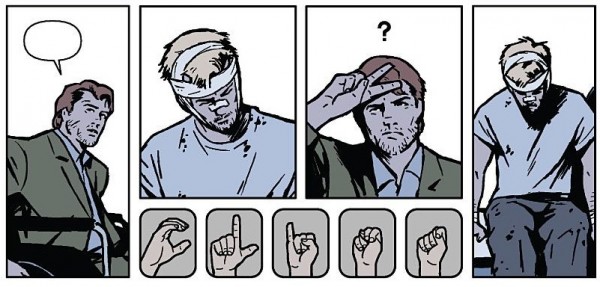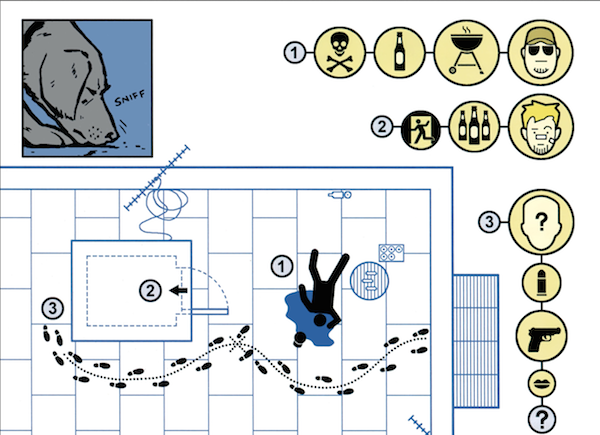Hawkeye’s hearing, or How to use signs in storytelling
Hi, everybody! Tim Carmody here, guest-hosting for Jason this week.
In the Marvel comic Hawkeye #15, published in February, the title character was brutally attacked and deafened by a supervillain real estate developer trying to push the hero’s neighbors out of their apartment building in Brooklyn’s Bed-Stuy. (It’s a very special comic book.) This week’s issue, #19, took months to finish but finally picks up that story line. It’s mostly told in a combination of silent panels, American Sign Language, and half-intelligible lip reading. It’s already being talked about as a shoo-in for this year’s Eisner award for best single issue.

There are precedents here. Last year’s mostly-silent Hawkeye #11 was told from the point of view of a dog (named Pizza Dog), using symbols and maps to tell a kind of detective story. (That issue also won writer Matt Fraction and artist David Aja the Eisner.)

There’s also a silent issue of Daredevil by Brian Michael Bendis and Alex Maleev where the blind superhero is temporarily deafened by an explosion. And there’s two gorgeous mini-arcs of Daredevil by writer/artist David Mack, featuring Maya Lopez as Echo, Daredevil’s deaf, super-powered love interest and counterpart.

Hawkeye’s also been temporarily deaf twice before: once in the limited series Hawkeye, back in the 1980s (his use of a hearing aid made him a minor hero to hearing-impaired readers) and (it’s revealed in this new issue) also as a child, as a result of an injury implied to be caused by his abusive father. This is how Clint and his brother Barney are shown to know American Sign Language.
I’ve been interested in ASL for a long time for personal reasons, but also as a kind of “writing,” in the family-resemblance sense of visible language, that functions like speech.
Comic books, at least in print, are a silent medium by necessity. But it’s still harder to render ASL in comics than ordinary oral/aural speech, because it’s a language of movement, and we don’t have the conventions of speech bubbles and the alphabet.
What we do have is a graphic tradition of maps, signs, atlases, manuals, and other forms of everyday iconography to draw on. And those are largely what Mack used in Daredevil, and what Aja uses in Hawkeye.
It’s a sign that we, all of us, read signs everywhere, and every kind of reading can be used and incorporated in every other kind. The best way to stay true to what’s essential in a medium is to do your best to explode your way out of it.





Stay Connected